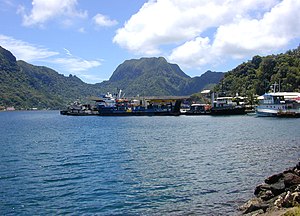Pago Pago
Pago Pago | |
|---|---|
| Country | United States |
| Territory | American Samoa |
Pago Pago (Template:Pron-en in English, but Error using {{IPA symbol}}: "ˈpaŋo ˈpaŋo" not found in list by native Samoan speakers) is the capital town of American Samoa. It is actually a village area that is often mistaken to be a city (as in a capital or port city) of this south Pacific territory of the United States of America. Its 2000 population was 11,500. The village is located on Pago Pago Harbor, in the island of Tutuila. Tourism, entertainment, food, and tuna canning are the primary industries here. From 1878 to 1951, this was a coaling and repair station for the U.S. Navy.


Pago Pago is one of the several villages in the Urban agglomeration of Pago Pago along the shore of "Pago Pago harbor" located at the very eastern part (inside) of the embayment. The area includes a number of villages, among them Fagatogo, the legislative and judicial area, and Utulei, the executive area (1).
However, because the name Pago Pago is associated with the harbor itself - the only significant port of call in American Samoa - Pago Pago is now generally applied not only to the village itself, but to the whole harbor area and to the villages in it.[1] It is in this sense that Pago Pago becomes the de facto capital town of American Samoa.
Pago Pago is a mixture of colorful semi-urban communities, a small town, tuna canneries (which provide employment for a third of the population of Tutuila) and a harbor surrounded by dramatic cliffs, which plunge almost straight into the sea. A climb to the summit of Mt. Alava (see National Park of American Samoa) provides a magnificent bird's-eye view of the harbor and town.
In January 1942 Pago Pago Harbor was shelled by a Japanese submarine, but this remained the only action on the islands during World War II.
Until 1980, one could experience the view from the peak by taking an aerial tramway over the harbor, but on April 17 (2) of that year a U.S. Navy plane, flying overhead as part of the Flag Day celebrations, struck the cable; the plane crashed into a wing of the Rainmaker Hotel. The tram remains unusable, although according to Lonely Planet, plans have been put forth to reopen it. Less spectacular, but worth the drive, is the view from the top of the pass above Aua Village on the road to Afono.
Both the port itself and the legislature of American Samoa — known as the "Fono" (/ˈfono/) — are in Fagatogo, a village adjacent to Pago Pago. Similarly, the once famous Rainmaker Hotel (now closed) is in the village of Utule‘i, adjacent to Fagatogo along the south shore of the long harbor. The canneries are in Atu‘u, on the harbor's north shore. It is suggested that one must avoid eating any fish or invertebrate caught in Pago Pago Harbor because they are contaminated with heavy metals and other pollutants.[2]
References in popular culture
- The action of the W. Somerset Maugham story 'Miss Thompson' aka 'Rain' is set in Pago Pago.
- 1940's movie, South of Pago Pago, starred Jon Hall, Victor Mclaughlin, and Francis Farmer.
- Doonesbury character "Uncle Duke" served a brief term as governor of American Samoa in a series of Doonesbury cartoons that ran in American newspapers in the mid 1970s. The series inspired the strip's creator, Garry Trudeau, and several friends to travel to American Samoa to personally witness life on the island, and their humorous misadventures were chronicled in the book Tales from the Margaret Mead Taproom (Kansas City: Sheed & Ward, 1976).
- Some versions of the Careers board game with "Go to Sea" as a career have an opportunity to earn happiness in the square "Terrific shore leave in Pago Pago". Game designer James Cooke Brown may have intended this as a sly reference to the Maugham story.
- Ramones' song "Touring" cites Bango Bango as one of the locations they were touring.
- Neoton Familia, a popular Hungarian Techno band of the 1960s, sung one of their major hits about Pago Pago.
- Comedian George Carlin referred to the town in one of his skits on his Jammin' in New York release when he said "Of course it's the local time, what did you think we were expecting, the time in Paga Pago?"
External links
- Pago Pago Village Information SamoaWorld
- Pago Pago, American Samoa National Weather Service Office
- Pago Pago Weather underground
14°16′46″S 170°42′02″W / 14.27944°S 170.70056°W
References
- ^ "American Samoa Constitution". Congress of the United States - Congressman Eni Faleomavaega. Retrieved 2007-02-16.
- ^ "Natural History Guide To American Samoa". nps.org. Retrieved 2007-02-16.
